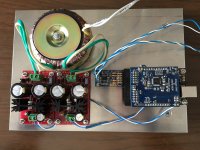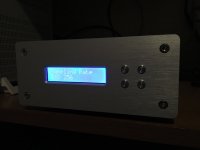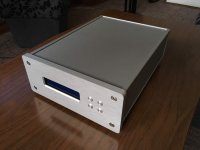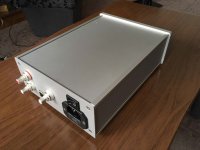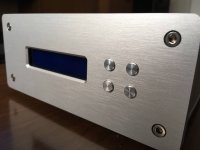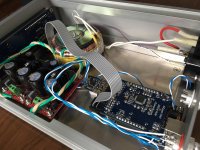Hi all...
does any one use JLsound USB to I2S card with Najda DSP ?
I need advice how to setup USBtoI2S card to work with Najda DSP which accept
''Data format is the most common, i.e. 64 bit clocks per sample period in 32-bit time-slots, with data aligned to the left''
does any one use JLsound USB to I2S card with Najda DSP ?
I need advice how to setup USBtoI2S card to work with Najda DSP which accept
''Data format is the most common, i.e. 64 bit clocks per sample period in 32-bit time-slots, with data aligned to the left''
Hi all...
does any one use JLsound USB to I2S card with Najda DSP ?
I need advice how to setup USBtoI2S card to work with Najda DSP which accept
''Data format is the most common, i.e. 64 bit clocks per sample period in 32-bit time-slots, with data aligned to the left''
inside USB/I2S card manual there is a table 1 for ESS (DATA_L DSD) and AKM (DATA_R DSD) compatibile DAC...which state to connect Pin 1 to Pin 5 via 4.7kOhm...but I think it's just for DSD materials)
It state;
- no connection for DATA_R DSD - THAT'S HOW IS NOW CONNECTED
- 4.7kOhm for DATA_L DSD
And there is table 2
- I2S no connection to PIN4,PIN6 (THIS WAS DEFOLT - DIDN'T WORK)
- LJ PIN6 to PIN1 via 4.7kOhm - THAT'S HOW IS NOW CONNECTED
- RJ 24bit PIN4 to PIN1
- RJ 16bit PIN4 and PIN6 to PIN1 via 4.7kOhm
Last few days testing http://jlsounds.com/drv.html..
Sound is surprisingly good.. for me even better than LME49710 board before opamps change..
Sound is surprisingly good.. for me even better than LME49710 board before opamps change..
Attachments
Hi all
I have USB to I2S working with Najda DSP (have bad connection)
But now I have to connect SPDIF output to my DAC with SPDIF input...
could someone point me out (on the picture) which of SPDIF outputs are + and which is GND ?
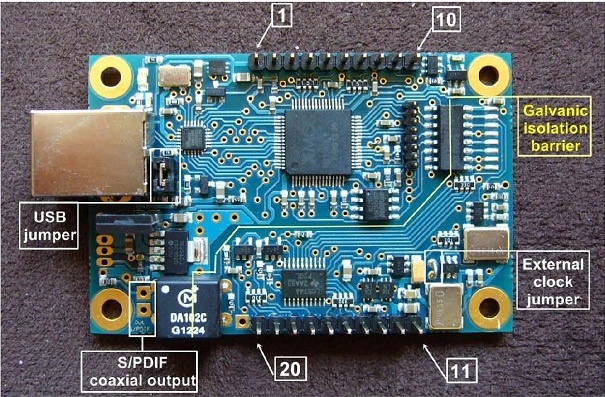
thanks
I have USB to I2S working with Najda DSP (have bad connection)
But now I have to connect SPDIF output to my DAC with SPDIF input...
could someone point me out (on the picture) which of SPDIF outputs are + and which is GND ?

thanks
Doesn't matter, board have isolation transformer..But now I have to connect SPDIF output to my DAC with SPDIF input...
could someone point me out (on the picture) which of SPDIF outputs are + and which is GND ?
I made few changes in the meantime.. first I unsloder 10uF tantalum, DRV603 can work without input capacitor with 5V PSU, but mute function doesn't work perfectly as with one.. after that I use 4,7uF multilayer ceramic, in theory better than tantalum, but practically hardly hear the difference.. in the end, instead of active 2nd order filter I made passive 1st order.. that is very easy on this board, just unsolder 6k2 and 150p replace with 8k2..Last few days testing http://jlsounds.com/drv.html..
Sound is surprisingly good..
???I had a look at the Audio Analyzer PDF. I think the THD is little to high.
http://www.diyaudio.com/forums/digi...mos-dsd-384-khz-32bit-usb-72.html#post4633656Very nice!
Where did you find those pushbuttons? Are they custom made?
Last few days testing http://jlsounds.com/drv.html..
Sound is surprisingly good.. for me even better than LME49710 board before opamps change..
I was tinkering about getting my card to work again for an HPA combo... So, using the DRV603 would simplify my layout. At stock, do you think it is better than the LME board?
This is my battery powered, tube output AK4490 DAC 🙂
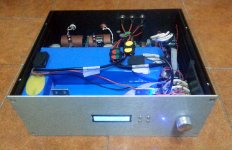
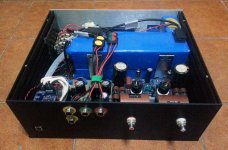
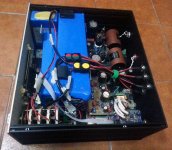
One of my friends has an identical DAC (i made it for him) - same configuration, same output stage - but with "normal" linear power supplies (very good ones, using Belleson regs and Mundorf filter caps).
Both DACs are a big level above any opamps-output-stage AK4490 i ever listened too. But this battery DAC SQ is the best... very, very very black background and holographic image!



One of my friends has an identical DAC (i made it for him) - same configuration, same output stage - but with "normal" linear power supplies (very good ones, using Belleson regs and Mundorf filter caps).
Both DACs are a big level above any opamps-output-stage AK4490 i ever listened too. But this battery DAC SQ is the best... very, very very black background and holographic image!

Last edited:
Schematic?Both DACs are a big level above any opamps-output-stage AK4490 i ever listened too. But this battery DAC SQ is the best... very, very very black background and holographic image!
Schematic?
No need for schematics, components are:
- Jlsounds i2soverusb and ak4490 dac,
- Broskie Cathode Follower as output stage using 7963 tubes @ 60Vdc,
- a simple low pass filter 2,2kohm + 2,2nF each output line (on prototyping board) between ak4490 and BCF,
- a simple antibump circuit copied from Jlsounds opamps output stage, in the same prototyping board.
It uses 4 batteries:
- a 60V one for anodes,
- a 14,8V one for filaments in series( 6,3V + 6,3V) regulated by a small diy lm1085 linear step down board to 12,6V,
- 2 x 7,4V batteries for ak4490 and i2soverusb, regulated by a lt3080 each on a modified (for DC) double linear ps board to 4,8V and 5,2V.
All batteries include a BMS and has both a charging wire and a discharging wire.
The charging wires go to colour coded chassis' chargers connectors; the discharging wires are switched by a heavy duty rotary selector that can stand 60Vdc switching.
Play time with fully charged batteries is about 10/15 hrs.
That's all, it's a quite simple diy project...
Last edited:
JLSounds opamp output stage sounds perfectly neutral with better opamp than LME49710, like AD797 or LT1363.. DRV603 sound surprisingly same as opamp stage, even better after changing input tantalum with multilayer caps..
I also changed reconstruction filter on both boards, and think I can hear difference..
I also changed reconstruction filter on both boards, and think I can hear difference..
JLSounds opamp output stage sounds perfectly neutral with better opamp than LME49710, like AD797 or LT1363.. DRV603 sound surprisingly same as opamp stage, even better after changing input tantalum with multilayer caps..
I also changed reconstruction filter on both boards, and think I can hear difference..
I tried Burson opamps too, as well as HDAM. Sound is very good, neutral, rich and detailed.
But a good tube output stage adds that "something" special that makes listening music a real pleasure, you become addicted to tubes!
I mean a more organic, "real" timbre and most of all a "presence" feeling i never heard even in very high end ss components. Instruments are just there, in front of you, with a 360° 3d definition that is really true life. It's not just a matter of being neutral...
IMHO, it's better to place tubes as high as possible in the reproduction chain, so dac output stage is the first candidate, preamp the second, power amp can be ss.
Last edited:
- Home
- Source & Line
- Digital Line Level
- XMOS DSD 384 kHz / 32bit USB
